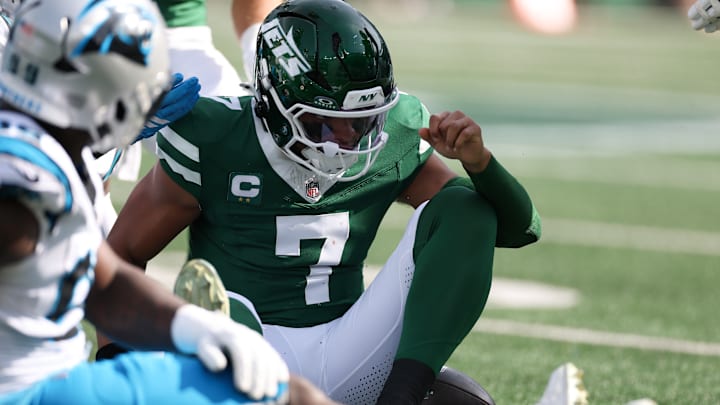One week after scoffing at reporters about the possibility of a quarterback change, New York Jets head coach Aaron Glenn reversed course and benched Justin Fields at halftime in favor of Tyrod Taylor against the Carolina Panthers. The Ohio State product finished just 6-for-12 for 46 yards and added 22 yards on four rushing attempts.
It was the breaking point of a disastrous seven-week stretch for Fields in green and white. He avoided turnovers but held the ball too long, missed open targets, and leaned too heavily on his legs, which only carried the offense so far.
Taylor was hardly perfect. He threw two interceptions and missed several passes, but he still gave his receivers opportunities to make plays. It wasn’t the solution, but a step in the right direction.
Fields could still reclaim the starting job and try to salvage his season, but this experiment has failed. And for first-year general manager Darren Mougey, it already stands as a significant stain on his résumé.
The bigger problem is that the fallout could linger for a long time.
Jets will pay a heavy price for the Justin Fields gamble
When Mougey signed Fields, he committed to a two-year, $40 million deal with $30 million guaranteed. That investment came with the expectation that Fields would step in and finally make a difference, with the support and confidence needed to live up to the potential of a former 11th overall pick.
Instead, if Fields never starts another game for the Jets, the deal would amount to roughly $5 million per start while he stands on the sideline. That’s an expensive mistake.
The financial fallout from cutting ties would be just as brutal. If the Jets release Fields this offseason, they would take on a $22 million dead cap hit, per Over The Cap, while freeing up only $1 million in cap space.
A post–June 1 cut would ease the blow with $10 million in savings, but it would also push dead money forward, including $13 million in 2026 and $3 million per year from 2027 through 2029.
The Jets could keep Fields through 2026, but unless something changes dramatically or this front office sees untapped potential, it’s entirely possible he won’t be on the roster a year from now.
And that would force the franchise right back into the quarterback market. They could spend a high pick in the 2026 NFL Draft on a prospect like Fernando Mendoza or LaNorris Sellers. They could explore another trade, as they did with Aaron Rodgers. Or they could dip back into free agency for another veteran option.
No matter the path, it’s going to cost them more cap space, and they still lack a clear heir apparent on the roster. Tyrod Taylor is well into his career and not a long-term solution. And with Mougey opting not to use a 2025 draft pick on a quarterback, there isn’t a young prospect worth developing behind him.
It all points to the same reality, as the Jets will once again have to reset at quarterback. It’s a cycle they’ve repeated far too often, from his year with Fields, in 2023 with Rodgers, in 2021 with Zach Wilson, in 2018 with Sam Darnold, and many times before. And unless something changes, they’ll be starting over yet again in 2026.
